Jacob Riis was born the third of fifteen children on May 3rd, 1849 in Denmark. He was a carpenter by trade when he headed to the United States in 1870. Like a lot of immigrant folks, he was unable to find work when he landed on New York’s hard-scrabble streets, and sought shelter wherever he could– often spending the night sleeping on the floor in temporary police station shelters. Through perseverance and hard work Riis landed a gig with a NYC news bureau in 1873, which eventually led to him becoming a police reporter for the New York Tribune. All too familiar himself with life on the NYC’s mean streets, he made it his personal mission to use his position to become the voice for the city’s suffering poor– especially the children. Jacob Riis strongly believed that the “poor were the victims, rather than the makers, of their fate.”
Manhattan’s Lower East Side, particularly the wretched areas known as Mulberry Bend and Bone Alley were teeming with poverty, violence and disease– “The whole district is a maze of narrow, often unsuspected passage ways—necessarily, for there is scarce a lot that has not two, three, or four tenements upon it, swarming with unwholesome crowds.” Jacob Riis wrote the epic, “How the Other Half Lives, Studies Among the Tenements of New York” published in 1890 (which also featured his iconic photography) to expose the horrible truth.
In 1895, Teddy Roosevelt sought Jacob Riis out, wanting to assist him in his efforts anyway he could. Then the acting President of the Board of Commissioners of the NYPD, Roosevelt asked Riis to personally show him the daily routine of street cops. On their first outing together, they uncovered nine out of ten patrolmen totally absent while on duty. Riis wrote of this, and it got the attention of everyone at the NYPD. The two became great friends, and after becoming President of the United States, Roosevelt said of Riis–
“Recently a man, well qualified to pass judgment, alluded to Mr. Jacob A. Riis as ‘the most useful citizen of New York.’ Those fellow citizens of Mr. Riis who best know his work will be most apt to agree with this statement. The countless evils which lurk in the dark corners of our civic institutions, which stalk abroad in the slums, and have their permanent abode in the crowded tenement houses, have met in Mr. Riis the most formidable opponent ever encountered by them in New York City.”
If it were not for the tireless work of Jacob Riis, the city’s poor may have long suffered with little hope. Riis was eventually successful in having the most crowded and dangerous areas torn down and replaced with new public parks and playgrounds. The infamous Mulberry Bend and Bone Alley areas gave way to Columbus Park, the Hamilton Fish Park and a public swimming pool, respectively.
In his last dying days, Riis recounted to a friend, “Now that I have to fight for almost every breath of air, I am more thankful than ever that I have been instrumental in helping the children of the tenements to obtain fresh air.”
Bandit’s Roost (1888), by Jacob Riis, from “How the Other Half Lives.” Bandit’s Roost, at 59½ Mulberry Street (Mulberry Bend), was the most crime-ridden, dangerous part of all New York City.
Mulberry Bend (ca. 1888), photo by Jacob Riis. “Five Points (and Mulberry Street), at one time was a neighborhood for the middle class. But when they had water problems because of an underground spring, the area was abandoned to the poor. It was the first American slum. In 1880 there were 37,000 tenements housing nearly 1.1 million people. Most were one or two room apartments. There was no running water and the bedrooms often had no windows at all. The buildings were so close together people could hand things across the alley, window to window. Mulberry Bend was one of the worst stretch of slums and in 1896 it was demolished to be turned into Columbus Park. Chinatown and Little Italy encroached, as did federal buildings to the south.” via
Mullen’s Alley (February 12, 1888), photo by Jacob Riis. “There were thousands of homeless children on the streets (of NYC), often abandoned by their parents… and in the summer months 3-4 babies would suffocate in the airless tenements every night.” via
ca. 1880-1890, Manhattan’s Lower East Side — Photo by Jacob Riis. “More than 100,000 immigrants lived in rear apartments (behind other buildings) that were wholly unfit for human habitation. In a room not thirteen feet either way slept twelve men and women, two or three in bunks set in a sort of alcove, the rest on the floor. There were also rooms where people could sleep for five cents a night, stranger next to stranger.” via
ca. 1888–1898 — Dens of Death — Photo by Jacob Riis
1891 — Portrait of a junk man’s living quarters in the cellar of a New York City tenement house. — Photo by Jacob Riis, Image © Bettmann/Corbis
1886, New York, NY — A peddler sits on his bedroll, atop two barrels, in the filthy cellar he lives in. — Photo by Jacob Riis, Image © Bettmann/Corbis
1890, New York, NY — A Jewish immigrant cobbler living in a dirty cellar prepares to eat a meal on the Sabbath. — Photo by Jacob Riis, Image © Bettmann/Corbis
1885, Lower East Side, NY — Shelter for immigrants in a Bayard Street tenement, where a group of men share one room. — Photo by Jacob Riis, Image © Bettmann/Corbis
ca. 1886 — Men sleep on the floor of a New York City homeless shelter. In 1886, the fee for sleeping indoors was five cents a night. — Photo by Jacob Riis, Image © Bettmann/Corbis
early 1890s, New York City — A group of women and children make a Manhattan police station their temporary home, ca. 1890. — Photo by Jacob Riis, Image by © Corbis
ca. 1885, New York City — An elderly woman sits in her dilapidated home and sews. She sleeps, cooks, and lives, all in one tiny room. — Photo by Jacob Riis, Image © Hulton-Deutsch Collection/Corbis
1890, New York City — In the Home of an Italian Rag-Picker, Jersey Street. An Italian mother sits in an area just off of Jersey Street and holds her baby. — Photo by Jacob Riis, Image © Corbis
ca. 1880s, New York City — Poor family in one room tenement apartment — Photo by Jacob Riis, Image © Bettmann/Corbis
1888 — In Poverty Gap, West 28 Street: an English Coal-Herver’s Home — Photo by Jacob Riis, Image © Bettmann/Corbis
ca. 1890 — Interior of a pantmaker’s workshop (sweatshop) on New York City’s Lower East Side, Ludlow Street. The total income of the entire family, working morning until night, is $8.00 per week. — Photo by Jacob Riis, Image © Hulton-Deutsch Collection/Corbis
1889 — A twelve year old boy works as a thread puller in a New York clothing factory sweatshop — Photo by Jacob Riis, Image © Corbis
1902, New York City — A classroom full of children in the condemned Essex Market School. A teacher demonstrates on the blackboard, as students watch attentively from crowded pews. Note the open gas jets near the ceiling used for lighting. — Photo by Jacob Riis, Image © Bettmann/Corbis
1890, New York — Homeless newsboys sleep huddled in a corner outside the Mulberry Street Church — Photo by Jacob Riis, Image © Bettmann/Corbis
ca. 1890, New York City — Girl Sitting on Doorstep with Baby on Her Lap — Photo by Jacob Riis, Image © Bettmann/Corbis
ca. 1890s, New York — Three homeless boys sleep on a stairway in a Lower East Side alley. — Photo by Jacob Riis, Image © Bettmann/Corbis
ca. 1888–1898 — Keep off the Grass — Photo by Jacob Riis
1888, New York City — Children’s Playground in Poverty Gap. Young boys play at a city playground. — Photo by Jacob Riis, Image © Corbis
1890, New York, NY –A blind man stands alone on a street corner, offering pencils for sale in New York City. — Photo by Jacob Riis, Image © Bettmann/Corbis
ca. 1900 — Bone Alley Park Site — Photo by Jacob Riis
ca. 1900 — Mulberry Bend Park — Photo by Jacob Riis
Little Italy, Mulberry Street, New York City by Detroit Publishing, ca. 1900 (Library of Congress)
Italian Neighborhood with Street Market, Mulberry Street, New York by Detroit Publishing, ca. 1900-1910 (Library of Congress)
Visit the NYC Tenement Museum here.








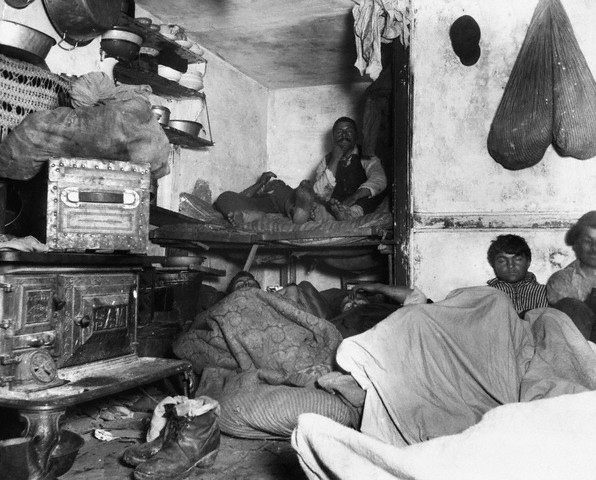
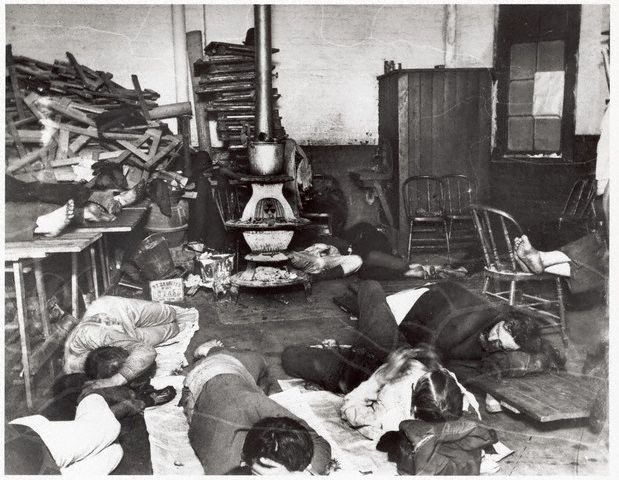



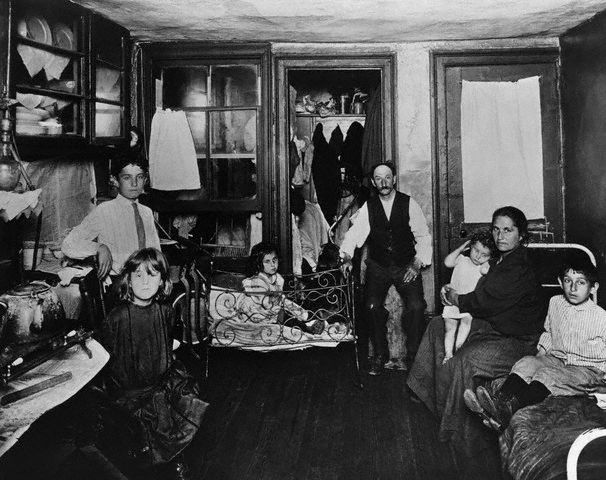






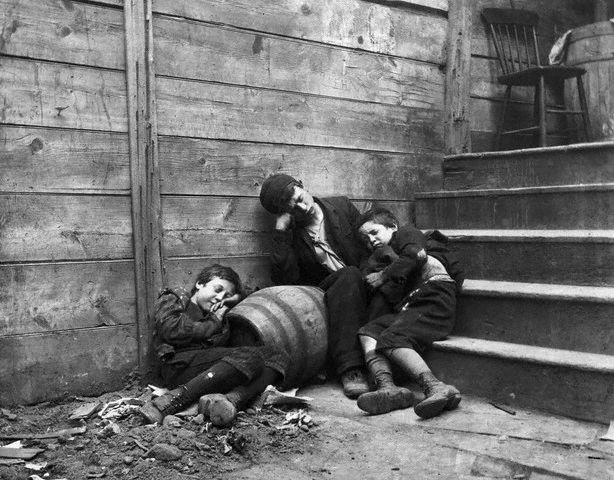



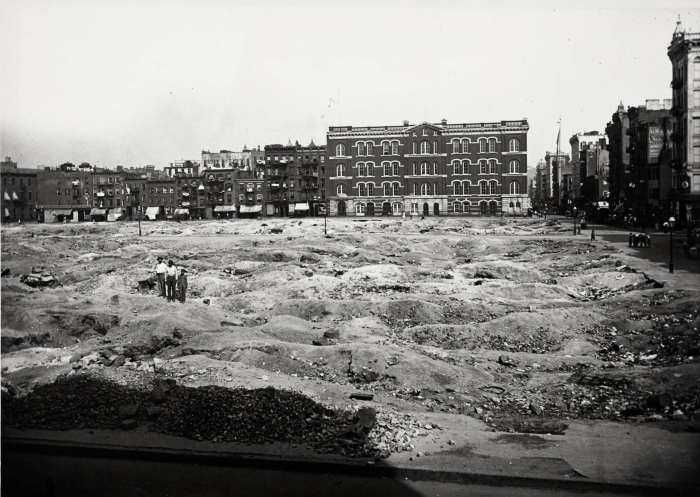

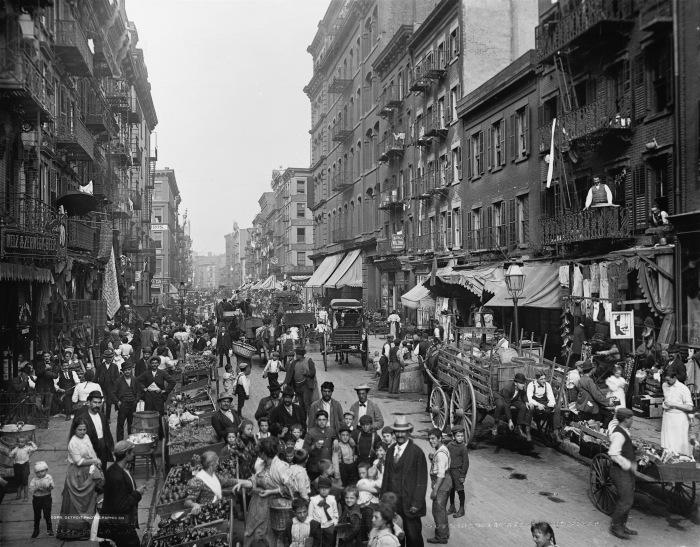

Thank you for the photos. Very telling of the human condition back then.
funny how some things change soo much and other things never seem to change at all…
xoxo
Fascinating look at ‘life through a lens’ in an era that seems so remote from the society we know. I really enjoyed The Gangs Of New York but felt, at the time, that it was probably not very ‘true to life’. It would appear my scepticism was somewhat naive.
Another great post!
learn
history
doomed
repeat
then repeat
THE thinking man’s blog
one of your very best
This is a GREAT post!!!
You are the best. So many perspectives.
Thank-you!
striking images-great find,as ever.the old photos always seem so un- posed and ‘somehow more real ‘-the homeless newsboys reminds me of squatting days-the bone alley park site would be fun on a moto-x bike-
see ‘ images of the western transvaal’ for more striking images of the human condition.
beware the gaze of ‘dressie and casey’
Please note the photo that accompanies this caption:
‘1890, New York — Homeless newsboys sleep huddled in a corner outside the Mulberry Street Church — Photo by Jacob Riis, Image © Bettmann/Corbis’.
Does anyone reading this know whether the ‘Mulberry St. Church’ mentioned is actually (Old) St. Patrick’s Church, still on Mulberry (built ~ 1815)? The shot of the massive blocks used seems identical.
And some kids bitch today because they can’t get a wii.
It would be interesting to see what some of these locations look like today.
Powerful post.
Grow up
???
Another great post! Thanks.
There were no “good old days”.
Thanks for this. Amazing.
What makes his interior shots even more amazing is his pioneering use of flash powder to light the darkness. NPR did a wonderful pice here:
http://www.npr.org/templates/story/story.php?storyId=91981589
JP, Since you like that “street stuff” photographically, and love the grittiness of this post, you would probably like this
Vivian Maier
http://www.vivianmaier.blogspot.com/
Brilliant images
Russ, my man-
I love Maier, amazing stuff and a great story.
JP
it’s insane that 100 yrs ago Mulberry Street meant poverty…now today it means to me Marc Jacobs and Magnolia bakery…
A visit to places such as São Paulo, Mumbai or Shenzen can illustrate how little has changed; the grinding poverty in every developing economy is a repeated history, as rickk rightly notes. Looking at the photo captioned “Children’s Playground in Poverty Gap”, one wonders if those boys pushing wheelbarrows really are at play, or training for a hard life to come.
I second Russ Aman’s recommendation of Vivian Maier… stumbled on that blog last year while looking for historic Chicago architectural photos. See the exhibition before it closes next month, if Chicago is in your travel plans.
If the tea baggers have their way, history may repeat itself. Who needs government?
Wow I just recently went tback to school to further my education and Jacob Riis is one of the authors we have learned about that were exposing certain conditions in early America.Some other material to check out would be the Upton Sinclair’s “The Jungle” pertaining to the sale of rotting meat with this same era and after it’s exposure came to light brought about the food and drug act that we have today.
These authors from the progressive era were called “Muckrackers” nice read thanks for posting.
awesome to the max 🙂
one of my favorite posts yet
wow. i walk through the mulberry bend park all the time. it still looks pretty much the same. more people now, mostly chinese immigrants.
great piece. one quibble. you quote another blog,
“Five Points (and Mulberry Street), at one time was a neighborhood for the middle class. But when they had water problems because of an underground spring, the area was abandoned to the poor. It was the first American slum.”
actually, from my reading my understanding is that what happened was that the collect pond which was about where the jail (a.k.a. the tombs) and court buildings are now had originally been a pristine water source. it wasn’t protected and with development it became an open sewer especially after tanning and slaughter houses opened upstream.
http://tinyurl.com/49devnm
This is great. More New York history please! I’m very familiar with Riis but some of these images were new to me. Great portrait… I don’t think there’s a great awareness of 19th century New York here. It gets eclipsed by the very visible boom of the 1920s and the many huge landmarks associated with that.
Josh is correct about Collect Pond.